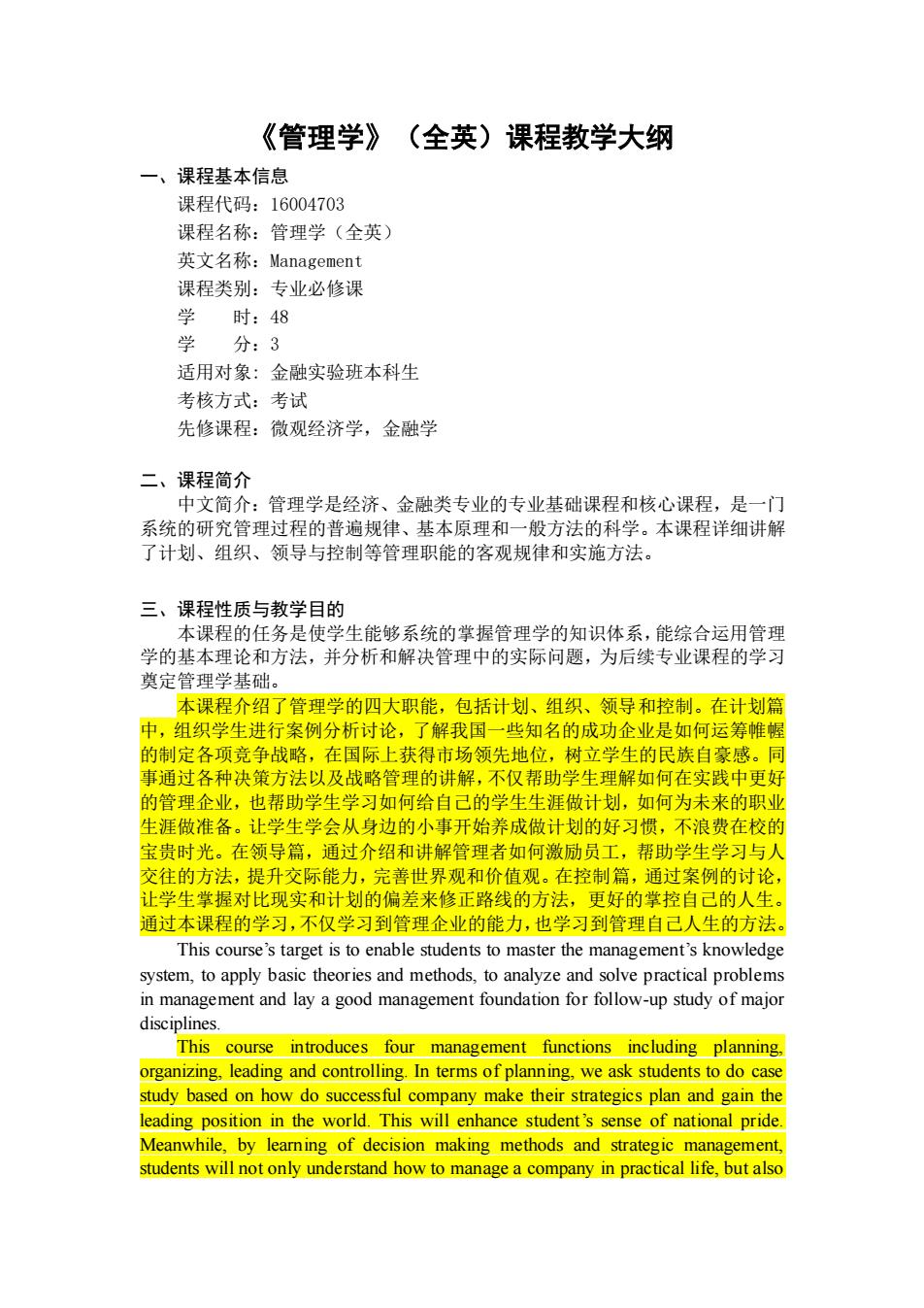
《管理学》(全英)课程教学大纲 一、课程基本信息 课程代码:16004703 课程名称:管理学(全英) 英文名称:Management 课程类别:专业必修课 学 时:48 学分:3 适用对象:金融实验班本科生 考核方式:考试 先修课程:微观经济学,金融学 二、课程简介 中文简介:管理学是经济、金融类专业的专业基础课程和核心课程,是一门 系统的研究管理过程的普遍规 律、基本原理和 般方法的科学。本课程详细讲解 了计划、组织、领导与控制等管理职能的客观规律和实施方法。 三、课程性质与教学目的 本课程的任务是使学生能够系统的掌握管理学的知识体系,能综合运用管理 学的基本理论和方法,并分析和解决管理中的实际问题,为后续专业课程的学习 奠定管理学基础 本课程介绍了管理学的四大职能,包括计划、组织、领导和控制。在计划篇 中,组织学生进行案例分析讨论,了解我国一些知名的成功企业是如何运筹帷蝎 的制定各项竞争战略,在国际上获得市场领先地位,树立学生的民族自豪感。同 事通过各种决策方法以及战略管理的讲解,不仅帮助学生理解如何在实践中更好 的管理企业,也帮助学生学习如何给自己的学生生涯做计划,如何为未来的职业 生涯做准备。 兰生 学会从身边的小 事开 养成做计划的好习惯 不浪费在校 宝贵时光。在领导篇,通过介绍和讲解管理者如何激励员工,帮助学生学习与人 交往的方法,提升交际能力,完善世界观和价值观。在控制篇,通过案例的讨论, 让学生掌握对比现实和计划的偏差来修正路线的方法,更好的掌控自己的人生, 通过本课程的学习,不仅学习到管理企业的能力,也学习到管理自己人生的方法 This course's target is to enable students to master the management's knowledge system,to apply basic theories and methods,to analyze and solve practical problems in management and lay a good management foundation for follow-up study of major disciplines. This course introduces four manage organizing leading and no ling.In terms of planning,we ask stude o do cas study based on how do successful company make their strategics plan and gain the leading position in the world.This will enhance student's sense of national pride. Meanwhile,by leamning of decision making methods and strategic management. students will not only understand how to manage a company in practical life.but also
《管理学》(全英)课程教学大纲 一、课程基本信息 课程代码:16004703 课程名称:管理学(全英) 英文名称:Management 课程类别:专业必修课 学 时:48 学 分:3 适用对象: 金融实验班本科生 考核方式:考试 先修课程:微观经济学,金融学 二、课程简介 中文简介:管理学是经济、金融类专业的专业基础课程和核心课程,是一门 系统的研究管理过程的普遍规律、基本原理和一般方法的科学。本课程详细讲解 了计划、组织、领导与控制等管理职能的客观规律和实施方法。 三、课程性质与教学目的 本课程的任务是使学生能够系统的掌握管理学的知识体系,能综合运用管理 学的基本理论和方法,并分析和解决管理中的实际问题,为后续专业课程的学习 奠定管理学基础。 本课程介绍了管理学的四大职能,包括计划、组织、领导和控制。在计划篇 中,组织学生进行案例分析讨论,了解我国一些知名的成功企业是如何运筹帷幄 的制定各项竞争战略,在国际上获得市场领先地位,树立学生的民族自豪感。同 事通过各种决策方法以及战略管理的讲解,不仅帮助学生理解如何在实践中更好 的管理企业,也帮助学生学习如何给自己的学生生涯做计划,如何为未来的职业 生涯做准备。让学生学会从身边的小事开始养成做计划的好习惯,不浪费在校的 宝贵时光。在领导篇,通过介绍和讲解管理者如何激励员工,帮助学生学习与人 交往的方法,提升交际能力,完善世界观和价值观。在控制篇,通过案例的讨论, 让学生掌握对比现实和计划的偏差来修正路线的方法,更好的掌控自己的人生。 通过本课程的学习,不仅学习到管理企业的能力,也学习到管理自己人生的方法。 This course’s target is to enable students to master the management’s knowledge system, to apply basic theories and methods, to analyze and solve practical problems in management and lay a good management foundation for follow-up study of major disciplines. This course introduces four management functions including planning, organizing, leading and controlling. In terms of planning, we ask students to do case study based on how do successful company make their strategics plan and gain the leading position in the world. This will enhance student’s sense of national pride. Meanwhile, by learning of decision making methods and strategic management, students will not only understand how to manage a company in practical life, but also

learn how to make a plan for themselves in college and how to prepare themselves for their future creer.We help st tudents to start mak ng plans from the ir daily life and no ster the trea sure time in school.In terms of le ling.by learning how to motivat employees,students learn how to communicate with other people.We help students to enhance their social skills and improve their world view and value view.In terms of controlling.by doing case study,students leam how to compare the reality to the plan and make ents in time to control their own life.By learning g this。 not only leamning how to manage a company,but also leam how to manage their life. 四、教学内容及要求 Chapter 1 Managementand Organizations Overall Objective:the goal here is to know 1.Understand why managers are important to organizations 2.Understand who managers are and where they work 3.Understand the functions.roles,and skills of managers Contents: I.Why are Managers Important? 2.Who Are Managers 2.1 Classifying Managers 22 Where do managers work? 3.What Do Managers Do? 3.I Effectiveness and Efficiency 3.2 Management Functions 3.3 Management Roles 3.4 Skills Managers Need Practice and Thinking Do the homework on the textbook and review the"terms to know" The homework for this chapter is to find your most appreciate Chinese manager and explain why you choose him or her.This homework conduct students to focus on Chinese co nies and discover excellent Chinese anagers.By learning the characteristic of these creative and brave managers.students want to be successful in the future more. Teaching Methods Classroom lecture,multimedia teaching and case study Chapter2 History of management Overall Objective:the goal here is to know 1.Understand some early management examples
learn how to make a plan for themselves in college and how to prepare themselves for their future career. We help students to start making plans from their daily life and not waster the treasure time in school. In terms of leading, by learning how to motivate employees, students learn how to communicate with other people. We help students to enhance their social skills and improve their world view and value view. In terms of controlling, by doing case study, students learn how to compare the reality to the plan and make adjustments in time to control their own life. By learning this course, students not only learning how to manage a company , but also learn how to manage their life. 四、教学内容及要求 Chapter 1 Management and Organizations Overall Objective: the goal here is to know 1. Understand why managers are important to organizations 2. Understand who managers are and where they work 3. Understand the functions, roles, and skills of managers Contents: 1. Why are Managers Important? 2. Who Are Managers 2.1 Classifying Managers 2.2 Where Do Managers Work? 3. What Do Managers Do? 3.1 Effectiveness and Efficiency 3.2 Management Functions 3.3 Management Roles 3.4 Skills Managers Need Practice and Thinking: Do the homework on the textbook and review the “terms to know”. The homework for this chapter is to find your most appreciate Chinese manager and explain why you choose him or her. This homework conduct students to focus on Chinese companies and discover excellent Chinese managers. By learning the characteristic of these creative and brave managers, students want to be successful in the future more. Teaching Methods: Classroom lecture, multimedia teaching and case study Chapter 2 History of management Overall Objective: the goal here is to know 1. Understand some early management examples
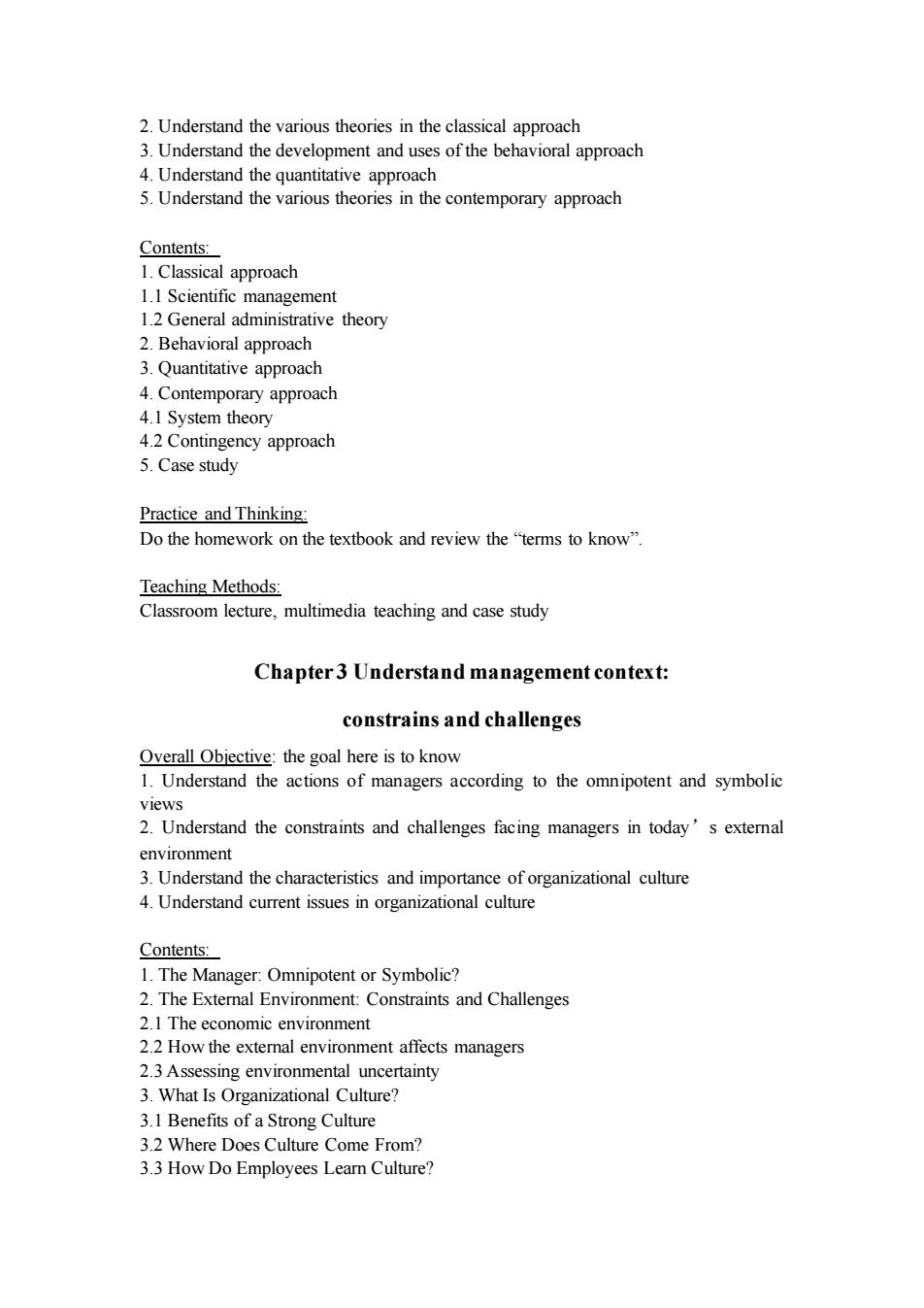
3.Understand the development and us s of the behavioral approach 4.Understand the quantitative approach 5.Understand the various theories in the contemporary approach Contents 1.Classical pproach 1.1 Scientific management 1.2 General administrative theory 2 Behavioral approach 3.Ouantitative approach rary approach 4.1 System theory 4.2 Contingency approach 5.Case study Practice and Thinking Do the homework on the textbook and review the"terms to know" Teaching Methods: Classroom lecture,multimedia teaching and case study Chapter 3 Understand management context: constrains and challenges Overall Objective:the goal here is to know 1.Understand the actions of managers according to the omnipotent and symbolic environment 3.Understand the characteristics and importance of organizational culture 4.Understand current issues in organizational culture Contents: I.The Manager:Omnipotent or Symbolic? 2.The External Environment:Constraints and Challenges 2.1 The economic environment 2.2 How the exten nal envir ent affects managers environment uncertainty 3.What Is Organizational Culture? 3.1 Benefits of a Strong Culture 3.2 Where Does Culture Come From? 3.3 How Do Employees Leam Culture?
2. Understand the various theories in the classical approach 3. Understand the development and uses of the behavioral approach 4. Understand the quantitative approach 5. Understand the various theories in the contemporary approach Contents: 1. Classical approach 1.1 Scientific management 1.2 General administrative theory 2. Behavioral approach 3. Quantitative approach 4. Contemporary approach 4.1 System theory 4.2 Contingency approach 5. Case study Practice and Thinking: Do the homework on the textbook and review the “terms to know”. Teaching Methods: Classroom lecture, multimedia teaching and case study Chapter 3 Understand management context: constrains and challenges Overall Objective: the goal here is to know 1. Understand the actions of managers according to the omnipotent and symbolic views 2. Understand the constraints and challenges facing managers in today’s external environment 3. Understand the characteristics and importance of organizational culture 4. Understand current issues in organizational culture Contents: 1. The Manager: Omnipotent or Symbolic? 2. The External Environment: Constraints and Challenges 2.1 The economic environment 2.2 How the external environment affects managers 2.3 Assessing environmental uncertainty 3. What Is Organizational Culture? 3.1 Benefits of a Strong Culture 3.2 Where Does Culture Come From? 3.3 How Do Employees Learn Culture?
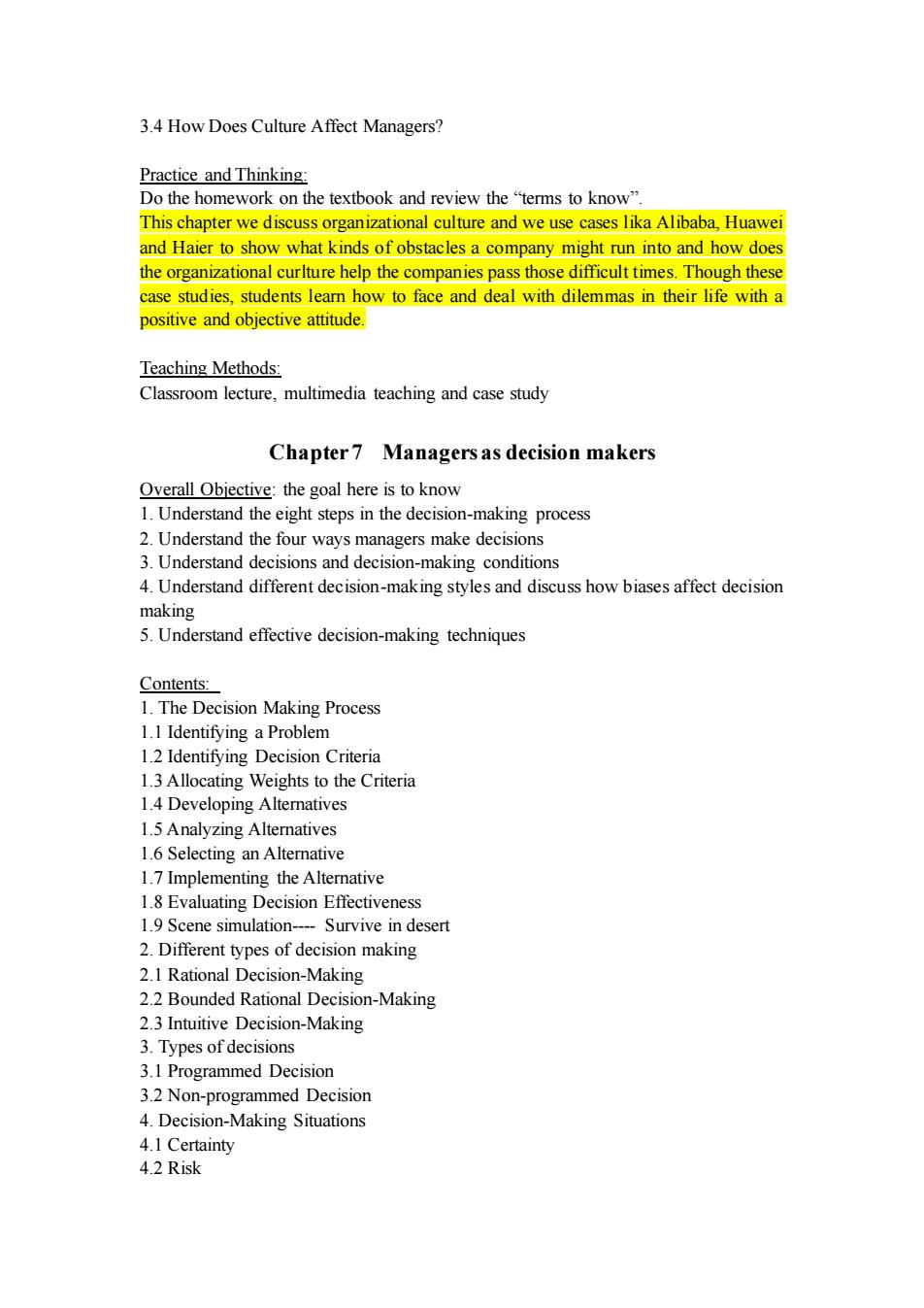
3.4 How Does Culture Affect Managers? Practice and Thinking. Do the homework on the textbook and review the"terms to know". This chapter we discuss organizational culture and we use cases lika Alibaba.Huawei and Haier to show what kinds of obstacles a company might run into and how does the Org onal curlture belr the ss those difficult times though thes pa e studies. ents leam w to face and deal with dilemmas in their life with a positive and objective attitude. Teaching Methods: Classroom lecture,multimedia teaching and case study Chapter7 Managersas decision makers Overall Objective:the goal here is to know 1.Understand the eight steps in the decision-making process 2.Understand the four wa e decis 3.Understand de 4.Understand different decision-making styles and discuss how biases affect decision making 5.Understand effective decision-making techniques 1.The Decision Making Process 1.1 Identifying a Problem 1.2 Identifying Decision Criteria 1.3 Allocating Weights to the Criteria 1.4 Developing Ale matives 1.5Analyzing Altematives 1.6 Selecting an Alternative 1.7 Implementing the Alternative 18 Evaluating Decision effectiveness 1 9 Scene simulation Survive in desert 2.Different types of decision making 2.1 Rational Decision-Making 2.2 Bounded Rational Decision-Making 2.3 Intuitive Decision-Making 3.Types of decisions 31 Programmed Decision 3.2 Non-programmed Decisior 4.Decision-Making Situations 4.1 Certainty 4.2 Risk
3.4 How Does Culture Affect Managers? Practice and Thinking: Do the homework on the textbook and review the “terms to know”. This chapter we discuss organizational culture and we use cases lika Alibaba, Huawei and Haier to show what kinds of obstacles a company might run into and how does the organizational curlture help the companies pass those difficult times. Though these case studies, students learn how to face and deal with dilemmas in their life with a positive and objective attitude. Teaching Methods: Classroom lecture, multimedia teaching and case study Chapter 7 Managers as decision makers Overall Objective: the goal here is to know 1. Understand the eight steps in the decision-making process 2. Understand the four ways managers make decisions 3. Understand decisions and decision-making conditions 4. Understand different decision-making styles and discuss how biases affect decision making 5. Understand effective decision-making techniques Contents: 1. The Decision Making Process 1.1 Identifying a Problem 1.2 Identifying Decision Criteria 1.3 Allocating Weights to the Criteria 1.4 Developing Alternatives 1.5 Analyzing Alternatives 1.6 Selecting an Alternative 1.7 Implementing the Alternative 1.8 Evaluating Decision Effectiveness 1.9 Scene simulation---- Survive in desert 2. Different types of decision making 2.1 Rational Decision-Making 2.2 Bounded Rational Decision-Making 2.3 Intuitive Decision-Making 3. Types of decisions 3.1 Programmed Decision 3.2 Non-programmed Decision 4. Decision-Making Situations 4.1 Certainty 4.2 Risk
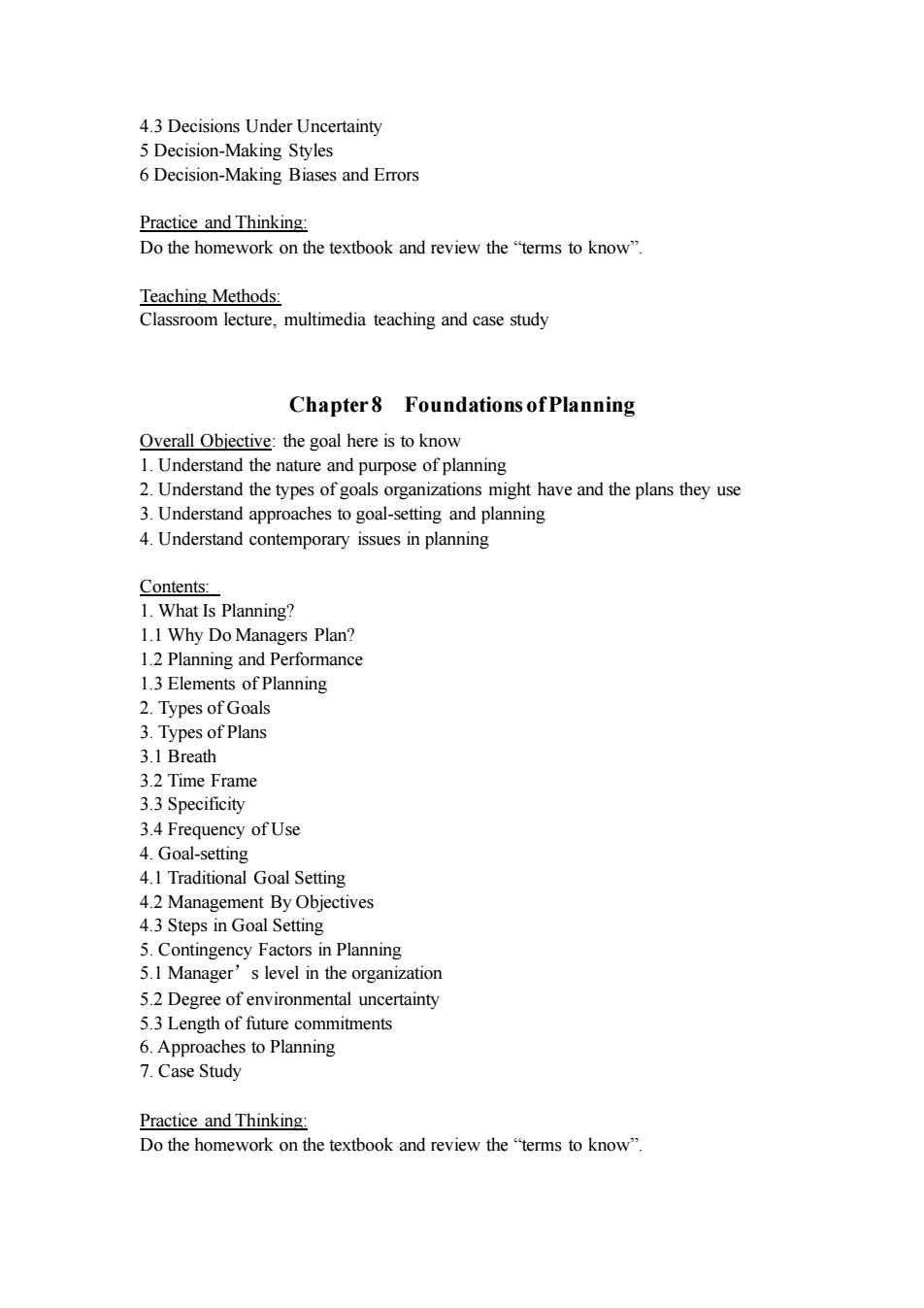
4.3 Decisions Under Uncertainty 5 Decision-Making Styles 6 Decision-Making Biases and Errors Practice and Thinking Do the homework on the textbook and review the"terms to know". Teaching Methods. Classroom lecture,multimedia teaching and case study Chapter8 Foundations of Planning Overall Objective:the goal here is to know 1.Understand the nature and purpose of planning 2.Understand the types of goals organizations might have and the plans they use 3 Understand appr aches to goal-setting and planning 4.Understand contemporary issues in planning Contents: 1.What Is Planning? 11 Why Do managers plan? 12Planning and Perfomance 1.3 Elements of Planning 2.Types of Goals 3.Types of Plans 3 1 Breath 3.2 Time Frame 3.4 Frequency of Use 4.Goal-setting 4.1 Traditional Goal Setting 4.2 Management By Objectives Steps Goal 5.Contingeney Facto s in Planning 5.1 Manager's level in the organization 5.2 Degree of environmental uncertainty 5.3 Length of future commitments aches to Plan ning 7.Case Study Practice and Thinking: Do the homework on the textbook and review the "terms to know
4.3 Decisions Under Uncertainty 5 Decision-Making Styles 6 Decision-Making Biases and Errors Practice and Thinking: Do the homework on the textbook and review the “terms to know”. Teaching Methods: Classroom lecture, multimedia teaching and case study Chapter 8 Foundations of Planning Overall Objective: the goal here is to know 1. Understand the nature and purpose of planning 2. Understand the types of goals organizations might have and the plans they use 3. Understand approaches to goal-setting and planning 4. Understand contemporary issues in planning Contents: 1. What Is Planning? 1.1 Why Do Managers Plan? 1.2 Planning and Performance 1.3 Elements of Planning 2. Types of Goals 3. Types of Plans 3.1 Breath 3.2 Time Frame 3.3 Specificity 3.4 Frequency of Use 4. Goal-setting 4.1 Traditional Goal Setting 4.2 Management By Objectives 4.3 Steps in Goal Setting 5. Contingency Factors in Planning 5.1 Manager’s level in the organization 5.2 Degree of environmental uncertainty 5.3 Length of future commitments 6. Approaches to Planning 7. Case Study Practice and Thinking: Do the homework on the textbook and review the “terms to know

Teaching Methods Classroom lecture,multimedia teaching and case study Chapter9 Strategic Management Overall Objective:the goal here is to know ategic manage ent and explain why it's important 2.Understand what managers do during the six steps of the strategic management process 3.Understand the three types of corporate strategies 4.Understand competitive advantage and the competitive strategies organizations us Contents: 1.What Is Strategic Management? Ma s current mission,goals,and strategies 2.2 Doing an extemal analysis 2 3 Doing an internal analysis 2.4 Formulating strategies 2.5 Implementing strategies 2Evaluating results Corporate Strategies 3.I Growth strategy 3.2 Stability strategy 3.3 Renewal strategy 3.4 BCG Matrix 4.Competitive strategies 4.1 Competitive advantage 4.2 Five Forces Model Practice and Thinking Do the homework on the textbook and review the"terms to know This chapter we discuss case of Huawei.In 2019's China-United States trade war face the trade ban of chips,Huawei's Haisi start to show itself and their domestically developed chips become useful.This shows that Huawei has taken precautions many yeas ago and has made a strategic plan to cope with the chip shortage in the future.By ing and dis e enhance students'senses of national pride ambitions to make contribution to the country. Teaching Methods: Classroom lecture.multimedia teaching and case studv
Teaching Methods: Classroom lecture, multimedia teaching and case study Chapter 9 Strategic Management Overall Objective: the goal here is to know 1. Understand strategic management and explain why it’s important 2. Understand what managers do during the six steps of the strategic management process 3. Understand the three types of corporate strategies 4. Understand competitive advantage and the competitive strategies organizations use to get it 5. Understand current strategic management issues Contents: 1. What Is Strategic Management? 2. Strategic Management Process 2.1 Identifying the organization’s current mission, goals, and strategies 2.2 Doing an external analysis 2.3 Doing an internal analysis 2.4 Formulating strategies 2.5 Implementing strategies 2.6 Evaluating results 3. Corporate Strategies 3.1 Growth strategy 3.2 Stability strategy 3.3 Renewal strategy 3.4 BCG Matrix 4. Competitive strategies 4.1 Competitive advantage 4.2 Five Forces Model Practice and Thinking: Do the homework on the textbook and review the “terms to know”. This chapter we discuss case of Huawei. In 2019’s China-United States trade war, face the trade ban of chips, Huawei’s Haisi start to show itself and their domestically developed chips become useful. This shows that Huawei has taken precautions many yeas ago and has made a strategic plan to cope with the chip shortage in the future. By learning and discussing this case, we enhance students’ senses of national pride and ambitions to make contribution to the country. Teaching Methods: Classroom lecture, multimedia teaching and case study

Chapter 10 Basic Organizational Design Overall Objective:the goal here is to know 1.Understand six key elements in organizational desigr 2.Understand 3.Understand he hat the mechanistic organic model of organizational design 4.Understand traditional organizational designs Contents Designing Organizational Structure 2.Organizational Design 2.1 Work specialization 2.2 Case study 2.3 Departmentalization 2.4 Chain of commanc 2.5 Case study 2.6 Span of control 2 7 Case study 2 8 Centralization and decentralization 29Case study 2.10 Formaliza 3.Mechanistic Vs Organic Organization 3.1 Mechanistic Organization 3.2 Organic Organization 4.Conti e o ency Factors g nizational Designs 5.1 Divisional structure 5.2 Matrix Structure 5.3 Project Structure Teaching Methods: Classroom lecture,multimedia teaching and case study Chapter 16 Motivating Employees Overall Objective:the goal here is to know 1.Understand motivation
Chapter 10 Basic Organizational Design Overall Objective: the goal here is to know 1. Understand six key elements in organizational design 2. Understand mechanistic and organic structures 3. Understand the contingency factors that favor either the mechanistic model or the organic model of organizational design 4. Understand traditional organizational designs Contents: 1. Designing Organizational Structure 2. Organizational Design 2.1 Work specialization 2.2 Case study 2.3 Departmentalization 2.4 Chain of command 2.5 Case study 2.6 Span of control 2.7 Case study 2.8 Centralization and decentralization 2.9 Case study 2.10 Formalization 3. Mechanistic Vs Organic Organization 3.1 Mechanistic Organization 3.2 Organic Organization 4. Contingency Factors 5. Some Organizational Designs 5.1 Divisional structure 5.2 Matrix Structure 5.3 Project Structure Practice and Thinking: Do the homework on the textbook and review the “terms to know”. Teaching Methods: Classroom lecture, multimedia teaching and case study Chapter 16 Motivating Employees Overall Objective: the goal here is to know 1. Understand motivation

2.Understand early theories of motivation 3.Understand contemporary theories of motivatio 4.Understand current issues in motivation Contents: 1.What is Motivation? 11 Definition 2.Early Theories of Motivation 2 I maslow's hierarchy of needs 2.2 McGregor's Theories X and Y 2.3 Herz g's Two-Factor Th 24 McClelland's Three Needs Theory 3.Contemporary Theories of Motivation 3.1 Reinforcement Theory 3 2 Eguity Theory 3.3 Expectancy Theory Practice and Thinking: Do the homework on the textbook and review the"terms to know" This chapter we discuss Haidilao.Haidilao pays a lot of attentions on employee motivation.Besides regular material motivation,Haidilao gives great responsibilities to employe so tha employees car act their poten and leadin ablityAndhatfwhy Haidmoyworkthtpassion and provide nice service to the customers.By discussing this case,students can understand that further cooperation and success is based on mutual respect of each other. Teaching Methods. Classroom lecture,multimedia teaching and case study Chapter 18 Introduction to Controlling Overall Objective:the goal here is to know 1.Understand the nature and importance of control 2.Understand the three steps in the control process 3.Understand how organizational performance is measured 4.Understand tools used to measure orga ional performance 5.Understand contemporary issues in control Contents: 1.What Is Control?
2. Understand early theories of motivation 3. Understand contemporary theories of motivation 4. Understand current issues in motivation Contents: 1. What is Motivation? 1.1 Definition 1.2 Case Study 1.3 Motivation Process 2. Early Theories of Motivation 2.1 Maslow’s Hierarchy of Needs 2.2 McGregor’s Theories X and Y 2.3 Herzberg’s Two-Factor Theory 2.4 McClelland’s Three Needs Theory 3. Contemporary Theories of Motivation 3.1 Reinforcement Theory 3.2 Equity Theory 3.3 Expectancy Theory Practice and Thinking: Do the homework on the textbook and review the “terms to know”. This chapter we discuss Haidilao. Haidilao pays a lot of attentions on employee motivation. Besides regular material motivation, Haidilao gives great responsibilities to employees, so that the employees can act their potential creativeness and leading ability. And that’s one of the reason why Haidilao’s employee work with great passion and provide nice service to the customers. By discussing this case, students can understand that further cooperation and success is based on mutual respect of each other. Teaching Methods: Classroom lecture, multimedia teaching and case study Chapter 18 Introduction to Controlling Overall Objective: the goal here is to know 1. Understand the nature and importance of control 2. Understand the three steps in the control process 3. Understand how organizational performance is measured 4. Understand tools used to measure organizational performance 5. Understand contemporary issues in control Contents: 1. What Is Control?
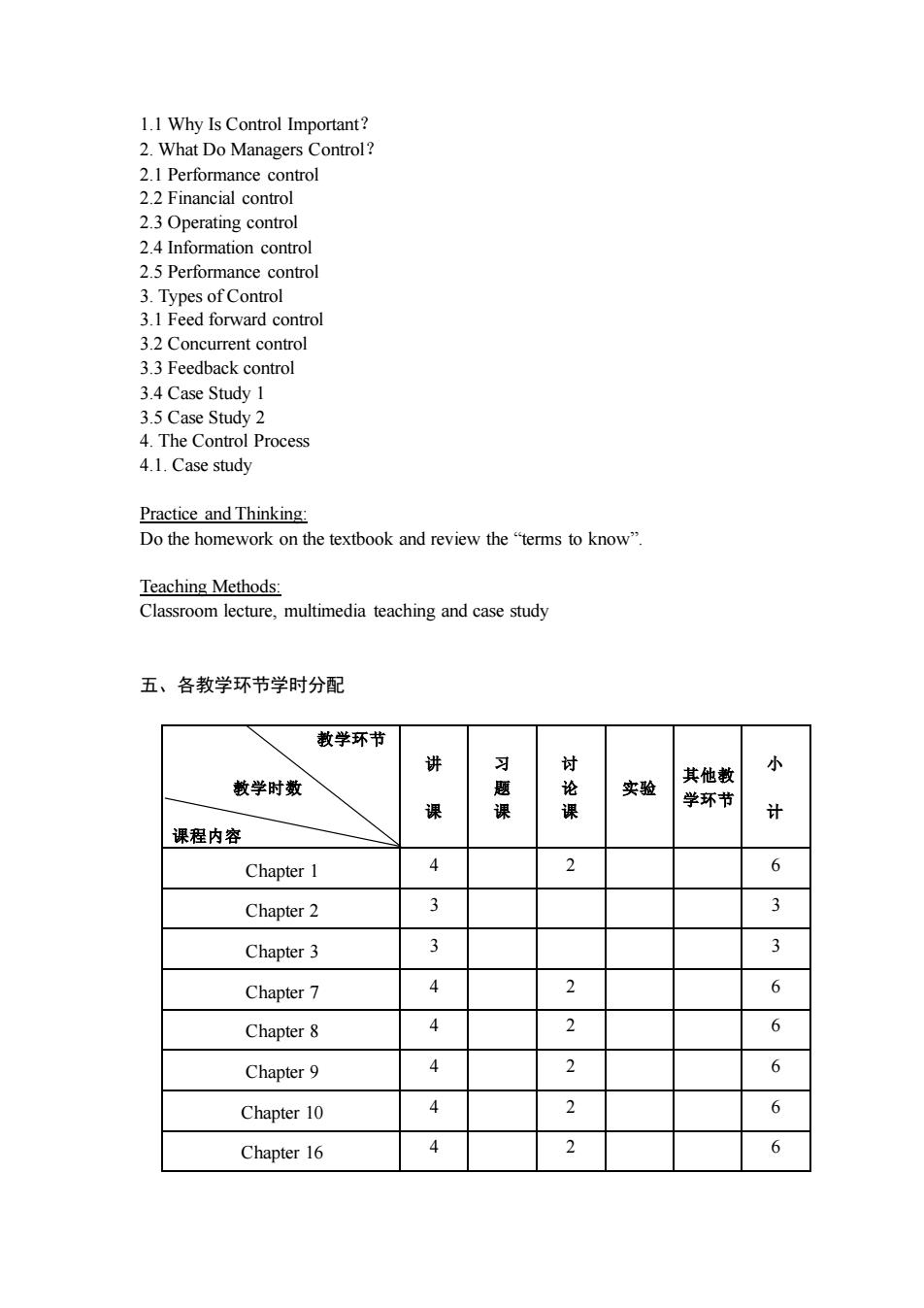
1.1 Why Is Control Important? 2.What Do Managers Control? 2.1 Performance control 2.2 Financial control 2.3 Operating control 2.4 Information control 2.5 Perform nce 3.1 Feed forward contro 3.2 Concurrent control 3.3 Feedback control 3.4 Case Study 1 3.5Case Study2 4.The Control Process 4.1.Case study Practice and Thinking Do the homework on the textbook and review the"terms to know" Teaching Methods: Classroom lecture,multimedia teaching and case study 五、各教学环节学时分配 教学环节 讲 习 讨 教学时数 实验 其他散 学环节 课程内容 Chapter 1 2 6 Chapter 2 3 Chapter 3 Chapter7 2 6 Chapter 8 4 2 6 Chapter9 4 6 Chapter 10 4 6 Chapter 16 4 2 6
1.1 Why Is Control Important? 2. What Do Managers Control? 2.1 Performance control 2.2 Financial control 2.3 Operating control 2.4 Information control 2.5 Performance control 3. Types of Control 3.1 Feed forward control 3.2 Concurrent control 3.3 Feedback control 3.4 Case Study 1 3.5 Case Study 2 4. The Control Process 4.1. Case study Practice and Thinking: Do the homework on the textbook and review the “terms to know”. Teaching Methods: Classroom lecture, multimedia teaching and case study 五、各教学环节学时分配 教学环节 教学时数 课程内容 讲 课 习 题 课 讨 论 课 实验 其他教 学环节 小 计 Chapter 1 4 2 6 Chapter 2 3 3 Chapter 3 3 3 Chapter 7 4 2 6 Chapter 8 4 2 6 Chapter 9 4 2 6 Chapter 10 4 2 6 Chapter 16 4 2 6
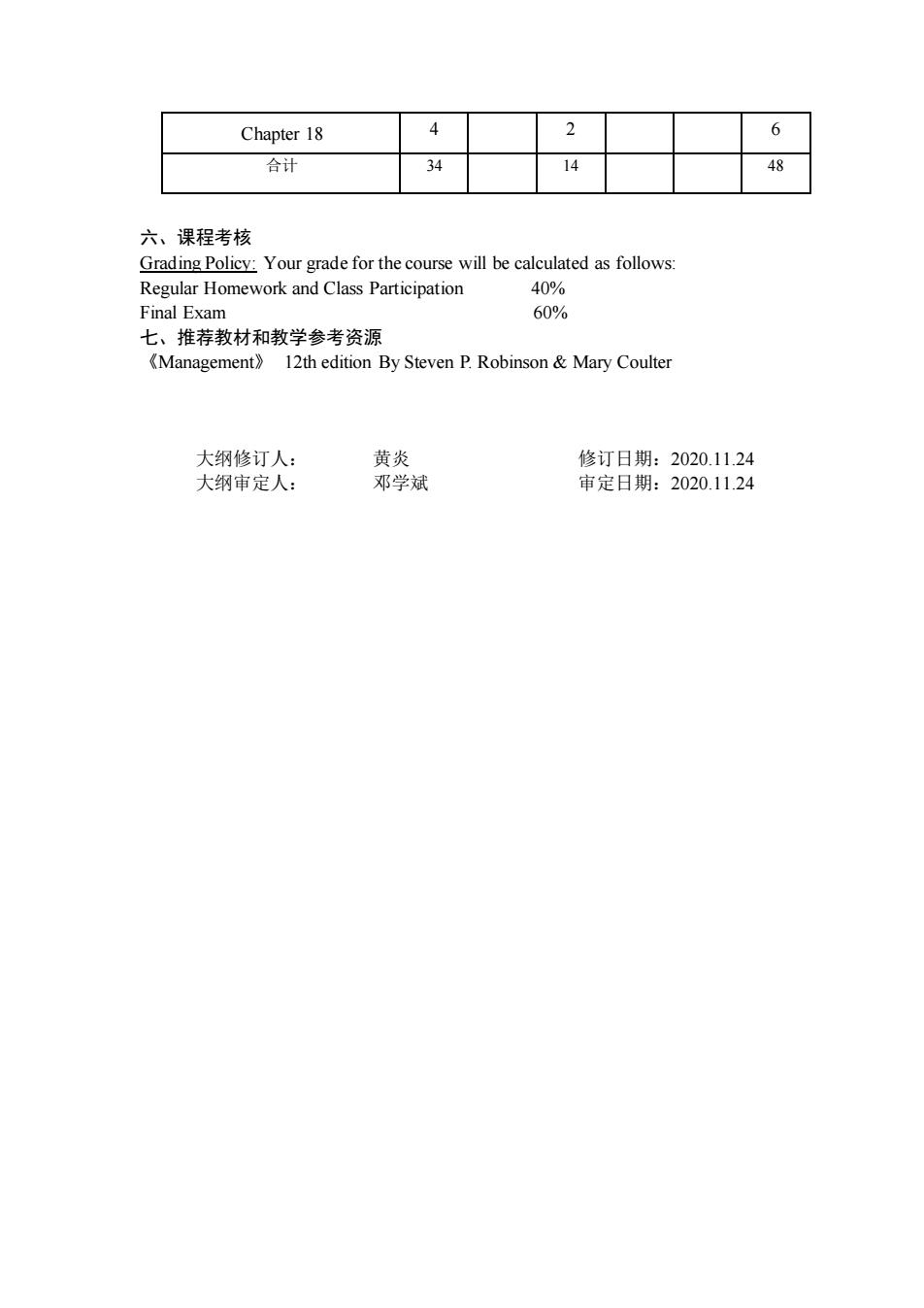
Chapter 18 4 2 6 合计 34 14 48 六、课程考核 Grading Policy.Your grade for the course will be calculated as follows: Regular Homework and Class Participation 40% Final Exam 60% 七、推荐教材和教学参考资源 《Management》 12th edition By Steven P.Robinson Mary Coulter 大纲修订人: 黄炎 修订日期:2020.1124 大纲审定人 邓学斌 审定日期:2020.11.24
Chapter 18 4 2 6 合计 34 14 48 六、课程考核 Grading Policy: Your grade for the course will be calculated as follows: Regular Homework and Class Participation 40% Final Exam 60% 七、推荐教材和教学参考资源 《Management》 12th edition By Steven P. Robinson & Mary Coulter 大纲修订人: 黄炎 修订日期:2020.11.24 大纲审定人: 邓学斌 审定日期:2020.11.24